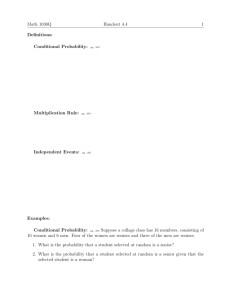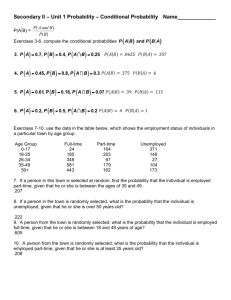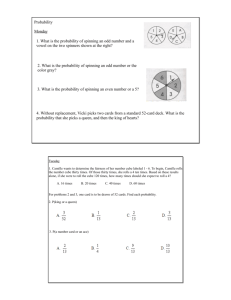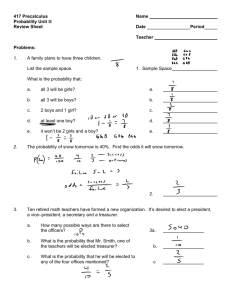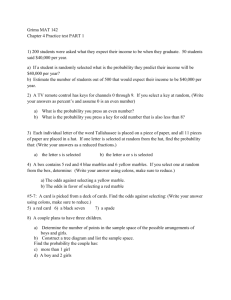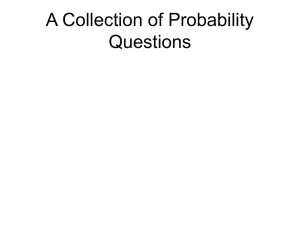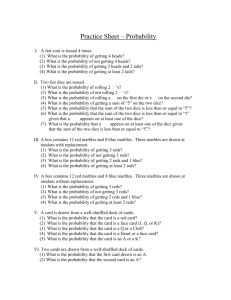Conditional Probability Worksheet
advertisement
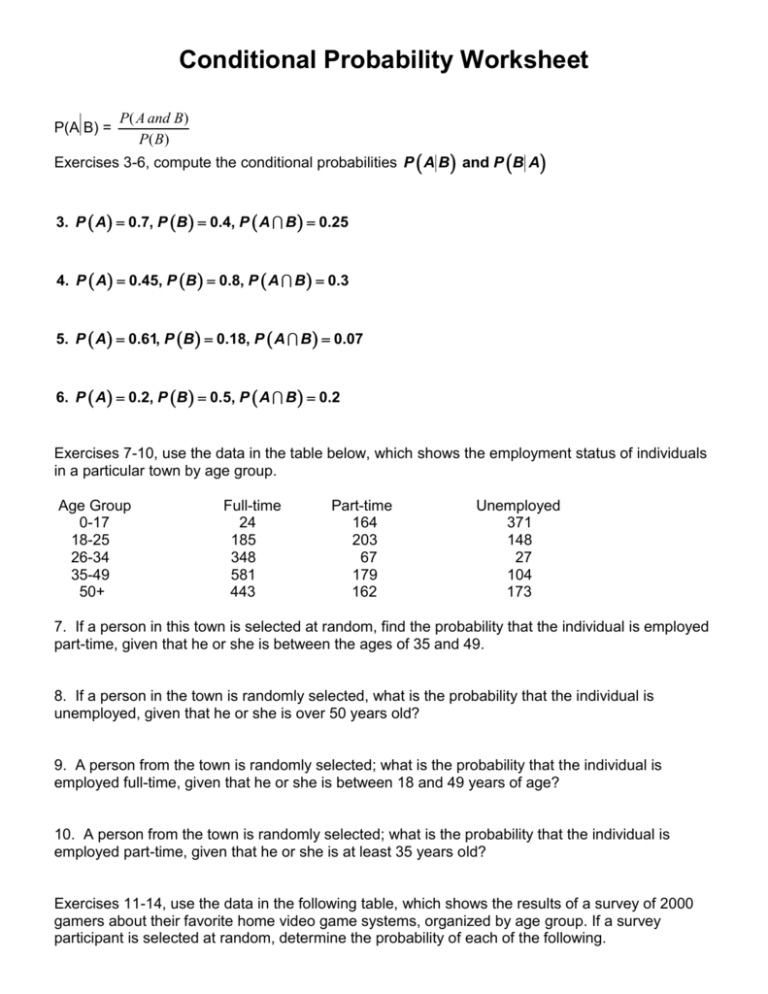
Conditional Probability Worksheet P(A B) = P( A and B) P( B) Exercises 3-6, compute the conditional probabilities P A B and P B A 3. P A 0.7, P B 0.4, P A 4. P A 0.45, P B 0.8, P A 5. P A 0.61, P B 0.18, P A 6. P A 0.2, P B 0.5, P A B 0.25 B 0.3 B 0.07 B 0.2 Exercises 7-10, use the data in the table below, which shows the employment status of individuals in a particular town by age group. Age Group 0-17 18-25 26-34 35-49 50+ Full-time 24 185 348 581 443 Part-time 164 203 67 179 162 Unemployed 371 148 27 104 173 7. If a person in this town is selected at random, find the probability that the individual is employed part-time, given that he or she is between the ages of 35 and 49. 8. If a person in the town is randomly selected, what is the probability that the individual is unemployed, given that he or she is over 50 years old? 9. A person from the town is randomly selected; what is the probability that the individual is employed full-time, given that he or she is between 18 and 49 years of age? 10. A person from the town is randomly selected; what is the probability that the individual is employed part-time, given that he or she is at least 35 years old? Exercises 11-14, use the data in the following table, which shows the results of a survey of 2000 gamers about their favorite home video game systems, organized by age group. If a survey participant is selected at random, determine the probability of each of the following. 0-12 13-18 19-24 25+ Sony PlayStation 2 63 105 248 191 607 Microsoft Xbox 84 139 217 166 606 Nintendo GameCube 55 92 83 88 318 Sega Dreamcast 51 253 113 449 169 717 136 571 469 2000 11. The participant prefers the Sony PlayStation 2 system. 12. The participant prefers the Microsoft Xbox, given that the person is between the age of 13 and 18. 13. The participant prefers Nintendo GameCube, given that the person is between the ages of 13 and 24. 14. The participant is under 12 years of age, given that the person prefers the Sega Dreamcast machine. 15. A pair of dice are tossed. Find the probability that the sum on the two dice is 8, given that the sum is even. 16. A pair of dice are tossed. Find the probability that the sum on the two dice is 12, given that doubles are rolled. 17. A pair of dice are tossed. What is the probability that doubles are rolled, given that the sum on the two dice is less than 7? 18. A pair of dice are tossed. What is the probability that the sum on the two dice is 8, given that the sum is more than 6? 19. What is the probability of drawing two cards in succession (without replacement) from a standard deck and having them both be face cards? 20. Two cards are drawn from a standard deck without re- placement. Find the probability that both cards are hearts. 21. Two cards are drawn from a standard deck without replacement. What is the probability that the first card is a spade and the second card is red? 22. Two cards are drawn from a standard deck without replacement. What is the probability that the first card is a king and the second card is not? In Exercises 23-26, a snack-size bag of M&Ms candies is opened. Inside, there are 12 red candies, 12 blue, 7 green, 13 brown, 3 orange, and 10 yellow. Three candies are pulled from the bag in succession, without replacement. 23. Determine the probability that the first candy drawn is blue, the second is red, and the third is green. 24. Determine the probability that the first candy drawn is brown, the second is orange, and the third is yellow. 25. What is the probability that the first two candies drawn are green and the third is red? 26. What is the probability that the first candy drawn is orange, the second is blue, and the third is orange? In Exercises 27-30, three cards are dealt from a shuffled standard deck of playing cards. 27. Find the probability that the first card dealt is red, the second is black, and the third is red. 28. Find the probability that the first two cards dealt are clubs and the third is a spade. 29. What is the probability that the three cards dealt are, in order, an ace, a face card, and an 8? (A face card is a jack, queen, or king.) 30. What is the probability that the three cards dealt are, in order, a red card, a club, and another red card? In Exercises 31-34, the probability that a student enrolled at a local high school will be absent on a particular day is 0.04, assuming that the student was in attendance the previous school day. However, if a student is absent, the probability that he or she will be absent again the following day is 0.11. For each exercise, assume that the student was in attendance the previous day. 31. What is the probability that a student will be absent three days in a row? 32. What is the probability that a student will be absent two days in a row, but then show up on the third day? 33. Find the probability that a student will be absent, at- tend the next day, but then will be absent again the third day. 34. Find the probability of tossing a pair of dice three times in succession and getting a sum of at least 10 on all three tosses. 35. Find the probability of tossing a pair of dice three times in succession and getting a sum of at most 3 on all three tosses. 34. Find the probability that a student will be absent four days in a row. In Exercises 35-38, determine whether the events are independent. 35. A single die is rolled and then rolled a second time. . 36. Numbered balls are pulled from a bin one-by-one to determine the winning lottery numbers. 37. Numbers are written on slips of paper in a hat; one person pulls out a slip of paper without replacing it, then a second person pulls out a slip of paper. 38. In order to determine who goes first in a game, one person picks a number between 1 and 10, then a second person picks a number between 1 and 10. In Exercises 39-44, a pair of dice are tossed twice. 39. Find the probability that both rolls give a sum of 8. 40. Find the probability that the first roll is a sum of 6 and the second roll is a sum of 12. 41. Find the probability that the first roll is a total of at least 10 and the second roll is a total of at least 11. 42. Find the probability that both rolls result in doubles. 43. Find the probability that both rolls give even sums. 44. Find the probability that both rolls give at most a sum of 4. 45. A fair coin is tossed four times in succession. Find the probability of getting two heads followed by two tails. 46. In the game of Monopoly, a player is sent to jail if he or she rolls doubles with a pair of dice three times in a row. What is the probability of rolling doubles three times in succession? Exercises 49-54, a card is drawn from a standard deck then replaced. After the deck is shuffled, another card is pulled. 49. What is the probability that both cards pulled are aces? 50. What is the probability that both cards pulled are face cards? 51. What is the probability that the first card drawn is a spade and the second card is a diamond? 52. What is the probability that the first card drawn is an ace and the second card is not an ace? 53. Find the probability that the first card drawn is a heart and the second card is a spade. 54. Find the probability that the first card drawn is a face card and the second card is black. 55. A standard deck of playing cards is shuffled and three people each choose a card. Find the probability that the first two cards chosen are diamonds and the third card is black if a. the cards are chosen with replacement. b. the cards are chosen without replacement. 56. A standard deck of playing cards is shuffled and three 1 people each choose a card. Find the probability that all three cards are face cards if a. the cards are chosen with replacement. b. the cards are chosen without replacement. 57. A bag contains five red marbles, four green marbles, and eight blue marbles. Find the probability of pulling two red marbles followed by a green marble if the marbles are pulled from the bag a. with replacement. b. without replacement. 58. A box contains three medium t-shirts, five large t-shirts, and four extra-large t-shirts. If someone randomly chooses three t-shirts from the box, find the probability that the first t-shirt is large, the second is medium, and the third is large if the shirts are chosen a. with replacement. b. without replacement. 59. A company that performs drug testing guarantees that its test determines a positive result with 97% accuracy. However, the test also gives 6% false positives. If 5% of those being tested actually have the drug present in their bloodstream, find the probability that a person testing positive has actually been using drugs. 60. A test for a genetic disorder can detect the disorder with 94% accuracy. However, the test will incorrectly report positive results for 3% of those without the disorder. If 12% of the population has the disorder, find the probability that a person testing positive actually has the genetic disorder. 61. A pharmaceutical company has developed a test for a scarce disease that is present in 0.5% of the population. The test is 98% accurate in determining a positive result, and the chance of a false positive is 4%. What is the probability that someone who tests positive actually has the disease? 62. When used together, the ELISA and Western Blot tests for HIV are more than 99% accurate in determining a positive result. The chance of a false positive is between 1 and 5 for every 100,000 tests. If we assume a 99% accuracy rate for correctly identifying positive results and 5/100,000 false positives, find the probability that someone who tests positive has HIV. (The Centers for Disease Control and Preventi6n estimate that about 0.3% of U.S. residents are infected with HIV.)

